Marrakech (Arabic: مراكش, Berber: ⴰⵎⵓⵔⴰⴽⵓⵛ), also spelt Marrakesh, is one of the imperial cities of Morocco.
The name Marrakech originates from the Amazigh (Berber) words mur (n) wakush, which means "Land of God". It is the third largest city in Morocco after Casablanca and Rabat, and lies near the foothills of the snow-capped Atlas Mountains and a few hours away from the foot of the Sahara Desert. Its location and contrasting landscape has made it an enviable destination in Morocco.
The city is divided into two parts: the Medina, the historical city, and the new European modern district called Gueliz or Ville Nouvelle. The Medina is full of intertwining narrow passageways and local shops full of character; it also contains the large square Djemaa El-Fna, where many hotels are located and tourists, locals and vendors congregate. In contrast, Gueliz plays host to modern restaurants, fast food chains and big brand stores.
Marrakech is the main tourist destination in Morocco and thus it is also a place where many Moroccans try to become rich fast by ripping off tourists. This mentality is so widespread that even Moroccans are now ripped off whenever possible so that they call the city "Marrakech, Arnakech" - which rhymes in Arabic and translates to "Marrakech, Mafia". See the Scam section for more information.
For further information, you may also visit the Marrakech Tourist Information.
For further information, you may also visit the Marrakech Tourist Information.
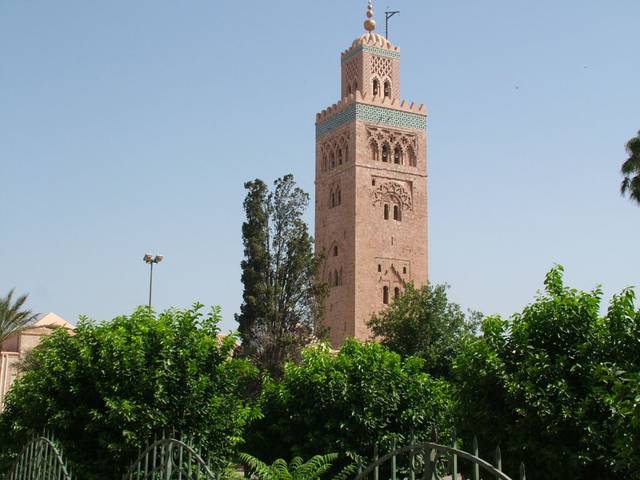
There is much to see and do in Marrakech. An entire day can be dedicated to wandering around all the different souks, seeking out the best bargains. The city also offers several historical and architectural sites as well as some interesting museums. In late 2018, the prices for most museums were raised from 10 dirham for foreigners to 70 dirham.
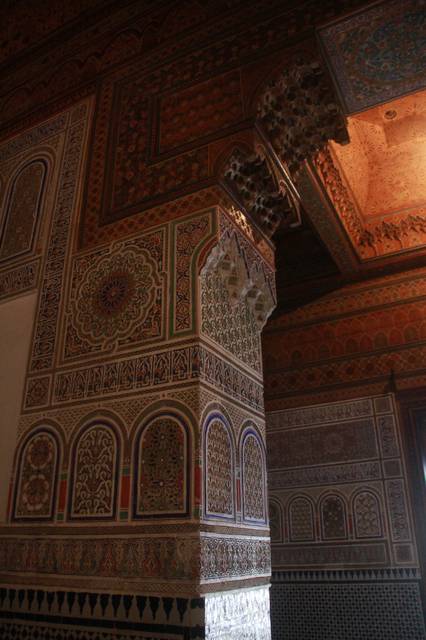
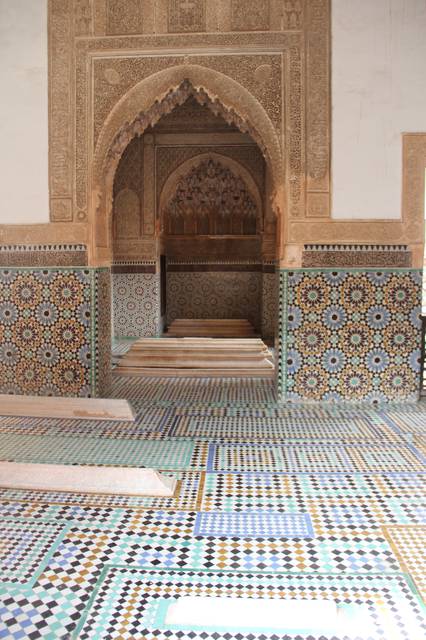
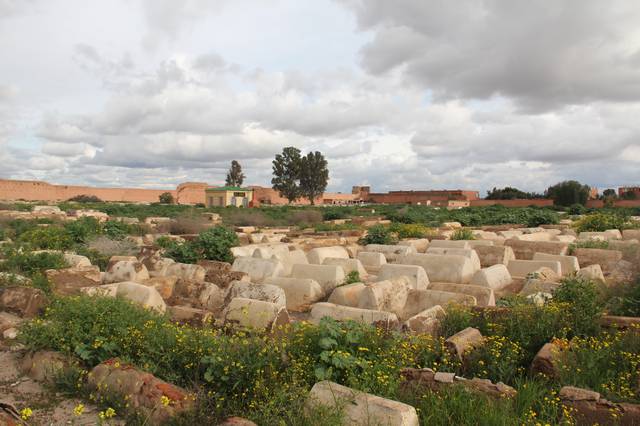
- Djemaa El-Fna. The highlight of any Marrakech night. Musicians, dancers, and story tellers pack this square at the heart of the medina, filling it with a cacophony of drum beats and excited shouts. Scores of stalls sell a wide array of Moroccan fare (see the Eat section) and you will almost certainly be accosted by women wanting to give you a henna tattoo. Enjoy the various shows, but be prepared to give some dirham to watch. By day it is largely filled with snake charmers and people with monkeys, as well as some of the more common stalls.
- The Souks. Markets of Marrakech, just adjacent to Place Djemaa El-Fna, are where you can buy almost anything, from spices to shoes, jellabas to kaftans, and tea pots to tagines. Undoubtedly, being a foreigner means you will end up paying higher prices than a native would, but be sure to bargain nonetheless. If you happen to run out of dirham, you will also find plenty of people in the souks who will eagerly exchange your dollars or euros (though a fair rate here is less likely than at an official exchange). All that said, the sellers here are much less aggressive than, say, Egypt, so have fun!
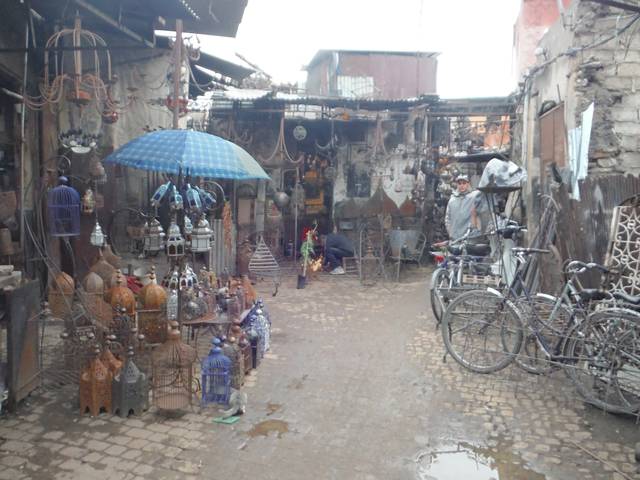
- Koutoubia Mosque. Named after the booksellers market that used to be located here. It is said that the minaret of the Koutoubia mosque is to Marrakech as the Eiffel Tower is to Paris. The minaret is visible from Gueliz which is connected to the Medina by Avenue Mohammed V. At night, the mosque is beautifully lit. It was completed under the reign of the Berber Almohad Caliph Yaqub al-Mansur (1184 to 1199), and has inspired other buildings such as the Giralda of Seville and the Hassan Tower of Rabat. Non-Muslims are not allowed inside.
- Tanneries. Visiting the tanneries can be an interesting experience. Even if some people tell you the area is only for locals, it is possible to visit the Tanneries without paying a youngster. After finding a tannery, ask one of the workers if you can visit it and take pictures
- Saadian Tombs. The tombs were not discovered until the beginning of the 20th century. They have been preserved just like they were during the glory days of the Saadian rulers. Unlike the El Badi Palace, they were not destroyed, probably for superstitious reasons. The entrance was blocked so they remained untouched for hundreds of years. Inside you will find an overload of Zelij (Morrocan tiles) and some beautiful decoration. It's rather small so it does not take a lot of time to explore. Also there are no explanatory signs whatsoever in the venue, so it's recommended to hire a guide to explain you what you're seeing to get the most out of your visit.
While here, look for the tombs of Jews and Christians; they are noted by their different markings and direction of the tomb. 70 dirham.
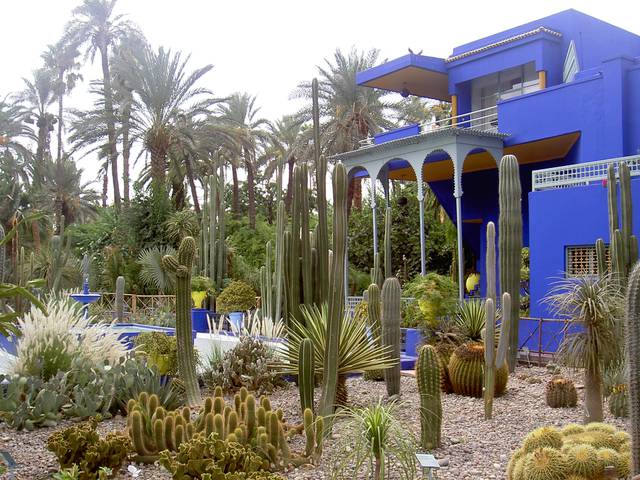
- Majorelle Gardens, Rue Yves Saint Laurent (In Gueliz, +212 5 24 31 30 47. Oct-Apr: 08:00-17:30, May-Sep: 08:00-18:00, Ramadan: 09:00-17:00. It provides an excellent respite from the hustle and bustle of the city streets, if not crowded by tourists as it sometimes is. The park was designed by the artist Jacques Majorelle in the 1920s and 1930s. Since 1980 the garden has been owned by Yves Saint-Laurent and Pierre Bergé. It boasts a collection of plants from around the globe, including what seems like every cactus species on the planet. Get here early to avoid the crowds. Inside the gardens is also the Berber Museum, which shows a slightly bigger and more modern presentation than the Dar Si Saïd. 70 dirham, 30 dirham extra for the Berber Museum.
- Yves Saint Laurent Museum, Rue Yves St Laurent (next door to Majorelle Gardens, +212 5242-98686. Th-Tu 10:00 - 18:00. 100 dirham.
- Dar Si Saïd Museum. 09:00–16:30. Museum set in an old palace with beautiful gardens. While somewhat run-down, it is worth seeing and houses many different artifacts from Morocco through the ages, such as wood carvings, musical instruments, and weapons. It is dedicated to the Moroccan craft industry of wood, gathering a very beautiful collection of popular art: carpets, clothing, pottery and ceramics. All these objects are regional, coming from Marrakech and all the south, especially from Tensift, High Atlas, Soussthe, Anti Atlas, Bani, and Tafilal. Locals: adults 10 dirham, children below 12 3 dirham; tourists: adults 70 dirham.
- Ben Youssef Madrasa, Kaat Benahid. 09:00-18:00, closed for religious holidays. One of the largest madrassas in the North Africa. It is a school attached to the Ben Youssef Mosque and is home to beautiful art and architecture. Build ca 1570. 40 dirham.
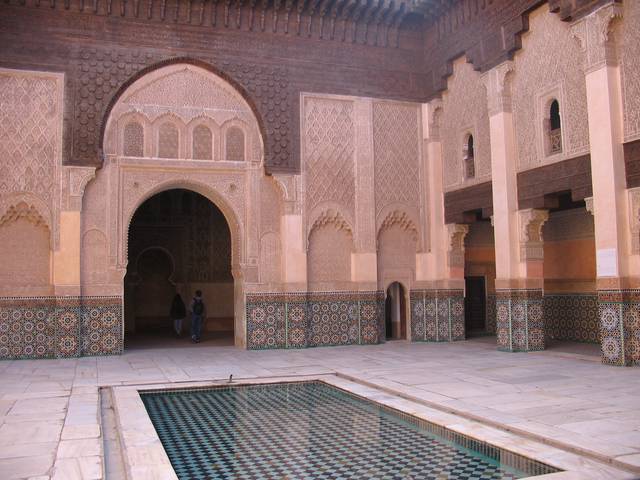
- El Bahia Palace. 08:00–17:00. An ornate and beautiful palace, build at the end of the 19th century for grand viziers of the sultan. Popular with guided tours and stray cats. The palace is well worth a visit and gives a great impression of what it must have been like to be a 19th-century nobleman in Morocco. There is a nice garden with banana flowers, tranquil courtyards, and other lovely plants. Attention must be given in finding the entrance. Google Maps will bring tourists nowhere near the entrance. The entrance is located on Riad Zitoun el Jdid, at 31.62089,-7.98414 Locals: adults 10 dirham, children below 12 3 dirham; tourists: adults 70 dirham.
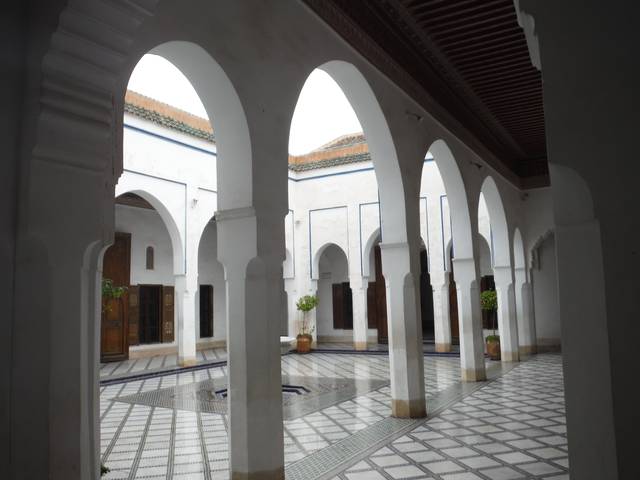
- El Badi Palace, Ksibat Nhass. 08:30-11:45, 14:45-17:45, museum 09:00-17:00. A palace now in ruins and inhabited by storks and stray cats. There are some underground passageways to explore with exhibitions within them. Note that most explanatory text is only in Arabic and French. Newer exhibitions have text in English as well but those are still the minority.
The view from the terrace is majestic. The palace was built by Sultan Ahmed al Mansour to celebrate the victory of the Portuguese army in 1578 in the Battle of the three kings.
They also exhibit a wooden minbar that dates back to the 12th century and is on display in a single room with some explanations. A minbar is a preaching chair.
Also hosts the Marrakech Museum for Photography and Visual Arts (abbreviated MMP+), a small museum which however showcases great pieces of visual art. 70 dirham admission to the palace (incl. museum).-HYirr.medium.jpg)
- The Menara gardens. 09:00-17:00. A mixture of orchards and olive groves surrounding the water reservoir with the central pavilion which is a popular sight on tourist postcards. Not a decorative garden, and now quite run down. The pavilion was built during the 16th-century Saadi dynasty, and renovated in 1869. It has a small cafe, but it is not open all hours. There are no toilets open when the cafe is closed. Free admission.
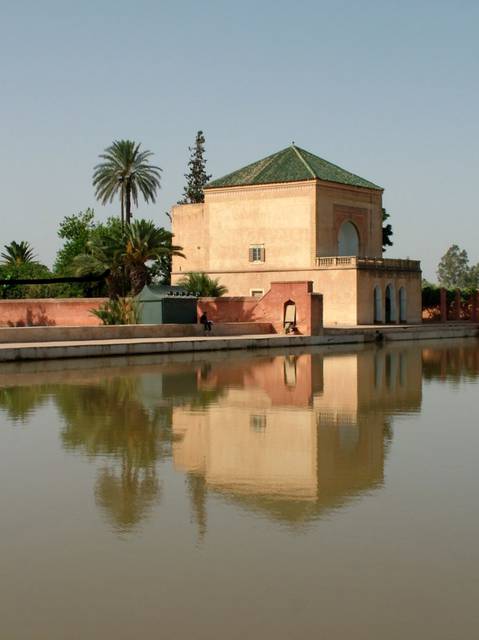
- Jewish Cemetery, Avenue Taoulat El Miara (adjacent to the mellah, within the medina. Open til 17:00. The largest Jewish cemetery in Morocco, characterized by white-washed tombs and sandy graves. The men selling tickets are full of interesting information about the cemetery but you have to ask. 10 dirham.
- Slat Al Azama Synagogue. Open til 18:00. Synagogue which is not only a place of worship with a beautiful open courtyard, but also includes interesting displays about Judaism's varied history in Morocco, including photos of Jews in the Berber Mountains. 10 dirham.
- Marrakech Museum, +212 24 44 18 93. 09:00-18:30. It's housed in the Dar Menebhi Palace, constructed at the end of the 19th century. 50 dirham.
- Musée de la Palmeraie, Dar Tounsi, Route de Fès (in the south of the Palmeraie, it is quite off the main tourist paths, expect to travel at about an hour per direction; you must get a taxi or bus 17 towards Palmeraie (which does not run often); the route with the museum is off to the left side of the road, the crossroads just before the Atacadao supermarket; you have to head follow the road for about 500 m, there are also signs, +212-661 09 53 52. 09:00-18:00?. In old agricultural buildings in the Palmeraie, made out of rammed earth. The architecture itself is interesting if you haven't seen it. It offers a small collection of contemporary art, with a room dedicated to Morrocan artists (also famous ones), the international ones are rather not top-notch. The gardens are nicely made and are good place to relax in quit. 40 dirham.
- Musee Farid Belkahia, Dar Tounsi, Route de Fès (at the seat of the Fondation Farid Belkahia, which is off Route de Fès, Dar Tounsi, walking past Musée de la Palmeraie for further 500 m-1 km. M-Sa. A museum dedicated to the renowned contemporary artist Farid Belkahia, showcasing different periods of his work
- Tiskiwin Museum, Derb El Bahia 8 (between El Bahia and Museum Dar Si Said. 09:00-12:30 and 14:30-18:00. About the people in the Sahara. Created by Dutchman Bert Flint. 30 dirham.
- Maison de la Photographie, 46, Rue souk Ahal Fès (200 m behind Ben Youssef Medersa - Koranic School. A little photography museum, it has one of the highest roof terraces in the Medina. 40 dirham.
- Ali Ben Youssef Mosque. The first mosque in Marrakesh was erected at this place by the Almoravid emir Yusuf ibn Tashfin in the 1070s. However, it was almost completely rebuilt in early 19th century by the Alaouite sultan Suleiman, with hardly any trace left of its original Amoravid or Almohad design. Non-Muslims are not allowed to enter it.
- Agdal Gardens. It consists of groves of orange, lemon, fig, apricot and pomegranate trees in rectangular plots, linked by olive-lined walkways. Together with the medina of Marrakech and the Menara Gardens, the Agdal Gardens were listed by UNESCO as a World Heritage Site in 1985. 70 dirham for foreign adults.
- Jbilets Geological Site. Explore the Berber village on a desert tour.
Jbilets Geological Site. Explore the Berber village on a desert tour.
Djemaa El-Fna. The highlight of any Marrakech night. Musicians, dancers, and story tellers pack this square at the heart of the medina, filling it with a cacophony of drum beats and excited shouts. Scores of stalls sell a wide array of Moroccan fare (see the Eat section) and you will almost certainly be accosted by women wanting to give you a henna tattoo. Enjoy the various shows, but be prepared to give some dirham to watch. By day it is largely filled with snake charmers and people with monkeys, as well as some of the more common stalls.
The Souks. Markets of Marrakech, just adjacent to Place Djemaa El-Fna, are where you can buy almost anything, from spices to shoes, jellabas to kaftans, and tea pots to tagines. Undoubtedly, being a foreigner means you will end up paying higher prices than a native would, but be sure to bargain nonetheless. If you happen to run out of dirham, you will also find plenty of people in the souks who will eagerly exchange your dollars or euros (though a fair rate here is less likely than at an official exchange). All that said, the sellers here are much less aggressive than, say, Egypt, so have fun!
Koutoubia Mosque. Named after the booksellers market that used to be located here. It is said that the minaret of the Koutoubia mosque is to Marrakech as the Eiffel Tower is to Paris. The minaret is visible from Gueliz which is connected to the Medina by Avenue Mohammed V. At night, the mosque is beautifully lit. It was completed under the reign of the Berber Almohad Caliph Yaqub al-Mansur (1184 to 1199), and has inspired other buildings such as the Giralda of [[Seville]] and the Hassan Tower of [[Rabat]]. Non-Muslims are not allowed inside.
Tanneries. Visiting the tanneries can be an interesting experience. Even if some people tell you the area is only for locals, it is possible to visit the Tanneries without paying a youngster. After finding a tannery, ask one of the workers if you can visit it and take pictures
Saadian Tombs. The tombs were not discovered until the beginning of the 20th century. They have been preserved just like they were during the glory days of the Saadian rulers. Unlike the El Badi Palace, they were not destroyed, probably for superstitious reasons. The entrance was blocked so they remained untouched for hundreds of years. Inside you will find an overload of Zelij (Morrocan tiles) and some beautiful decoration. It's rather small so it does not take a lot of time to explore. Also there are no explanatory signs whatsoever in the venue, so it's recommended to hire a guide to explain you what you're seeing to get the most out of your visit.
While here, look for the tombs of Jews and Christians; they are noted by their different markings and direction of the tomb. 70 dirham.
Majorelle Gardens, Rue Yves Saint Laurent (In Gueliz, +212 5 24 31 30 47. Oct-Apr: 08:00-17:30, May-Sep: 08:00-18:00, Ramadan: 09:00-17:00. It provides an excellent respite from the hustle and bustle of the city streets, if not crowded by tourists as it sometimes is. The park was designed by the artist Jacques Majorelle in the 1920s and 1930s. Since 1980 the garden has been owned by Yves Saint-Laurent and Pierre Bergé. It boasts a collection of plants from around the globe, including what seems like every cactus species on the planet. Get here early to avoid the crowds. Inside the gardens is also the Berber Museum, which shows a slightly bigger and more modern presentation than the Dar Si Saïd. 70 dirham, 30 dirham extra for the Berber Museum.
Yves Saint Laurent Museum, Rue Yves St Laurent (next door to Majorelle Gardens, +212 5242-98686. Th-Tu 10:00 - 18:00. 100 dirham.
Dar Si Saïd Museum. 09:00–16:30. Museum set in an old palace with beautiful gardens. While somewhat run-down, it is worth seeing and houses many different artifacts from Morocco through the ages, such as wood carvings, musical instruments, and weapons. It is dedicated to the Moroccan craft industry of wood, gathering a very beautiful collection of popular art: carpets, clothing, pottery and ceramics. All these objects are regional, coming from Marrakech and all the south, especially from Tensift, High Atlas, Soussthe, Anti Atlas, Bani, and Tafilal. Locals: adults 10 dirham, children below 12 3 dirham; tourists: adults 70 dirham.
Ben Youssef Madrasa, Kaat Benahid. 09:00-18:00, closed for religious holidays. One of the largest madrassas in the North Africa. It is a school attached to the Ben Youssef Mosque and is home to beautiful art and architecture. Build ca 1570. 40 dirham.
El Bahia Palace. 08:00–17:00. An ornate and beautiful palace, build at the end of the 19th century for grand viziers of the sultan. Popular with guided tours and stray cats. The palace is well worth a visit and gives a great impression of what it must have been like to be a 19th-century nobleman in Morocco. There is a nice garden with banana flowers, tranquil courtyards, and other lovely plants. Attention must be given in finding the entrance. Google Maps will bring tourists nowhere near the entrance. The entrance is located on Riad Zitoun el Jdid, at 31.62089,-7.98414 Locals: adults 10 dirham, children below 12 3 dirham; tourists: adults 70 dirham.
El Badi Palace, Ksibat Nhass. 08:30-11:45, 14:45-17:45, museum 09:00-17:00. A palace now in ruins and inhabited by storks and stray cats. There are some underground passageways to explore with exhibitions within them. Note that most explanatory text is only in Arabic and French. Newer exhibitions have text in English as well but those are still the minority.
The view from the terrace is majestic. The palace was built by Sultan Ahmed al Mansour to celebrate the victory of the Portuguese army in 1578 in the Battle of the three kings.
They also exhibit a wooden minbar that dates back to the 12th century and is on display in a single room with some explanations. A minbar is a preaching chair.
Also hosts the Marrakech Museum for Photography and Visual Arts (abbreviated MMP+), a small museum which however showcases great pieces of visual art. 70 dirham admission to the palace (incl. museum).
The Menara gardens. 09:00-17:00. A mixture of orchards and olive groves surrounding the water reservoir with the central pavilion which is a popular sight on tourist postcards. Not a decorative garden, and now quite run down. The pavilion was built during the 16th-century Saadi dynasty, and renovated in 1869. It has a small cafe, but it is not open all hours. There are no toilets open when the cafe is closed. Free admission.
Jewish Cemetery, Avenue Taoulat El Miara (adjacent to the mellah, within the medina. Open til 17:00. The largest Jewish cemetery in Morocco, characterized by white-washed tombs and sandy graves. The men selling tickets are full of interesting information about the cemetery but you have to ask. 10 dirham.
Slat Al Azama Synagogue. Open til 18:00. Synagogue which is not only a place of worship with a beautiful open courtyard, but also includes interesting displays about Judaism's varied history in Morocco, including photos of Jews in the Berber Mountains. 10 dirham.
Marrakech Museum, +212 24 44 18 93. 09:00-18:30. It's housed in the Dar Menebhi Palace, constructed at the end of the 19th century. 50 dirham.
Musée de la Palmeraie, Dar Tounsi, Route de Fès (in the south of the Palmeraie, it is quite off the main tourist paths, expect to travel at about an hour per direction; you must get a taxi or bus 17 towards Palmeraie (which does not run often); the route with the museum is off to the left side of the road, the crossroads just before the Atacadao supermarket; you have to head follow the road for about 500 m, there are also signs, +212-661 09 53 52. 09:00-18:00?. In old agricultural buildings in the Palmeraie, made out of rammed earth. The architecture itself is interesting if you haven't seen it. It offers a small collection of contemporary art, with a room dedicated to Morrocan artists (also famous ones), the international ones are rather not top-notch. The gardens are nicely made and are good place to relax in quit. 40 dirham.
Musee Farid Belkahia, Dar Tounsi, Route de Fès (at the seat of the Fondation Farid Belkahia, which is off Route de Fès, Dar Tounsi, walking past Musée de la Palmeraie for further 500 m-1 km. M-Sa. A museum dedicated to the renowned contemporary artist Farid Belkahia, showcasing different periods of his work
Tiskiwin Museum, Derb El Bahia 8 (between El Bahia and Museum Dar Si Said. 09:00-12:30 and 14:30-18:00. About the people in the Sahara. Created by Dutchman Bert Flint. 30 dirham.
Maison de la Photographie, 46, Rue souk Ahal Fès (200 m behind Ben Youssef Medersa - Koranic School. A little photography museum, it has one of the highest roof terraces in the Medina. 40 dirham.
Ali Ben Youssef Mosque. The first mosque in Marrakesh was erected at this place by the Almoravid emir Yusuf ibn Tashfin in the 1070s. However, it was almost completely rebuilt in early 19th century by the Alaouite sultan Suleiman, with hardly any trace left of its original Amoravid or Almohad design. Non-Muslims are not allowed to enter it.
Agdal Gardens. It consists of groves of orange, lemon, fig, apricot and pomegranate trees in rectangular plots, linked by olive-lined walkways. Together with the medina of Marrakech and the Menara Gardens, the Agdal Gardens were listed by UNESCO as a World Heritage Site in 1985. 70 dirham for foreign adults.
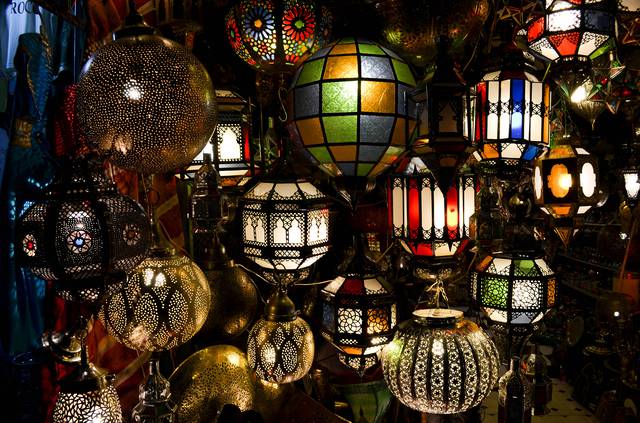
- Chez Ali Fantasia, La Palmeraie de Marrakech (10 km north of Marrakech, +212 5 24307730. Horse show, acrobats on Arabian horses firing rifles in the air, horseback acrobatics, belly dancing, etc. It takes place at night in a huge imitation of an old castle. €15.
The historic district of the city.
The main square in the Medina is Djemaa El-Fna. It is surrounded by endless labyrinths of souks (bazaars) and alley ways covering all of the Medina. Djemma El-Fna is a must as there is always something to see there day and night whether it be snake charmers, acrobats, sooth-sayers,or the musicians and food stalls. At night the square really comes to life as people navigate toward the exotic aromas and the entertaining sights. As the evening darkens, the hustle & bustle of activity rages on. The exotic music appears louder and more hypnotic.
The Medina is also the place to stay in a Riad, a Moroccan house with an internal courtyard. Most windows are inward facing towards the central atrium. This design of property suits Islamic tradition as there is no obvious wealth statement being made externally, no windows to peer through. Entering a Riad is like discovering an Aladdin's Cave in comparison to its non-descript exterior. They are great places to stay and offer an intimate and relaxing retreat.
Directly south of the Djemaa El-Fna is Rue Bab Agnaou. A five-min walk takes you straight to the famous Bab Agnaou entrance to the Kasbah district of the Medina. The Bab Agnaou entrance, through the ramparts, is by far the most impressive entrance of all medina rampart entrances.
The Kasbah, in comparison to the Derbs (streets) surrounding the Djemaa El-Fna, portrays a calmer, less abrasive atmosphere. It is home to the Royal Palace, also the former El - Badi Palace and the Saadian Tombs. This naturally creates better security, cleaner streets and a hint of being a special place within the medina. The Kasbah has its own little bazaars (Souikas), food stalls, restaurants, hotels and riads for travellers to enjoy.
Hammams are baths, often close to mosques to facilitate the performance of ablutions. In guidebooks and signs that call them "Moroccan Turkish Baths" the name "Turkish" is a misnomer, since Morocco (unlike Egypt or Syria) was never under Ottoman rule, but the historical role of the baths is authentic in Morocco.
- Les Bains de Marrakech, 2 Derb Sedra, Bab Agnaou (same building as Riad Mehdi) (inside Bab Agnaou, +212 438 1428. 09:00-19:30. Tourists-oriented in good sense: couples can have hammam together in a private room. Extensive list of massages and spa treatments from 30 min to a full day. Reception and attendants are proficient in speaking English, however, the scrubbing and massage personnel speak only very basic vocabulary. You need to book two days in advance. 170–1,400 dirham.
- Hammam Dar el-Bacha, 20 Rue Fatima Zohra. men 12:00-13:00, women 13:00-21:00.
- Hammam Bab Doukkala, Rue Bab Doukkala (southeast corner Bab Doukkala Mosque. women 07:00-19:00, men 20:00.
- Thai marrakech, Résidence Les Jasmins Apt N° 13 4ème étage Angle Av. Mohamed v et Rue Oum Errabia Guéliz, +212 524 433 304. Bann Thai institute is a beauty center based in the heart of Marrakech. His team is a graduate of the famous school of Wat Po in Bangkok. The center offers several Thai massage relaxation with a traditional Moroccan hammam natural products
- Hamam Essalama (traditional Hamam), Rue Moulay Abdellah (walking on Rue Moulay Abdellah, coming from Rue Bata or Rue Khalid Ben El Qualid, head towards Boulevard de Safi, the hamam is in the last block (just before Bvd Safi) at the near corner. till 17:00. Friendly staff, however, no English or French (other locals helped without any problem) 12 dirham entrance, 50 dirham scrub.
- Spa O'bain de lina for men (massage and hamam), 84, avenue Hassan II Guéliz Res Faroukia n2 (in the centre of Marrakech Gueliz, behind Café de la Poste near Hôtel Farouk, +212 661939873. Until 01:00. Friendly staff, however, no English or French (other customers likely to help you out).
Les Bains de Marrakech, 2 Derb Sedra, Bab Agnaou (same building as Riad Mehdi) (inside Bab Agnaou, +212 438 1428. 09:00-19:30. Tourists-oriented in good sense: couples can have hammam together in a private room. Extensive list of massages and spa treatments from 30 min to a full day. Reception and attendants are proficient in speaking English, however, the scrubbing and massage personnel speak only very basic vocabulary. You need to book two days in advance. 170–1,400 dirham.
Hammam Dar el-Bacha, 20 Rue Fatima Zohra. men 12:00-13:00, women 13:00-21:00.
Hammam Bab Doukkala, Rue Bab Doukkala (southeast corner Bab Doukkala Mosque. women 07:00-19:00, men 20:00.
Thai marrakech, Résidence Les Jasmins Apt N° 13 4ème étage Angle Av. Mohamed v et Rue Oum Errabia Guéliz, +212 524 433 304. Bann Thai institute is a beauty center based in the heart of Marrakech. His team is a graduate of the famous school of Wat Po in Bangkok. The center offers several Thai massage relaxation with a traditional Moroccan hammam natural products
Hamam Essalama (traditional Hamam), Rue Moulay Abdellah (walking on Rue Moulay Abdellah, coming from Rue Bata or Rue Khalid Ben El Qualid, head towards Boulevard de Safi, the hamam is in the last block (just before Bvd Safi) at the near corner. till 17:00. Friendly staff, however, no English or French (other locals helped without any problem) 12 dirham entrance, 50 dirham scrub.
Spa O'bain de lina for men (massage and hamam), 84, avenue Hassan II Guéliz Res Faroukia n2 (in the centre of Marrakech Gueliz, behind Café de la Poste near Hôtel Farouk, +212 661939873. Until 01:00. Friendly staff, however, no English or French (other customers likely to help you out).
Marrakesh is not in the desert: you will spend several hours to get to the desert and that day tours are therefore pretty stressful. If you have the time, spend at least one night in the desert or in a town close to your desert trekking destination. Beware of tours that don't include meals and water as they will drop you at 100 dirham restaurants far from any other option, because of this and the kickback from shops you will visit multi-day trips to Merzouga can cost as little as 600 dirham if you play agencies against each other.
Chez Ali Fantasia, La Palmeraie de Marrakech (10 km north of Marrakech, +212 5 24307730. Horse show, acrobats on Arabian horses firing rifles in the air, horseback acrobatics, belly dancing, etc. It takes place at night in a huge imitation of an old castle. €15.
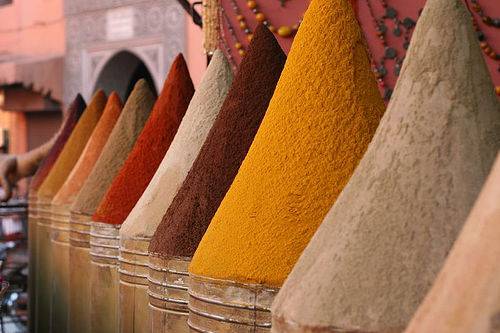
Along with the major souk (Arabic for 'market') adjacent to the Djemaa El-Fna, there are a plethora of smaller souks throughout the city where any number of products can be had. In any of them, you generally need to bargain. Keep an eye out for a wide array of hand-crafted candle-holding lanterns, as well as spectacular displays of local spices.
Most shops sell the same handful of items. But if you wander a little off from El-Fna, you can find small workshops with real craftsmen making handmade goods. You then get to talk to craftsmen that the item you bought. If you buy shoes or clothes that can also make alterations for you, and there a few places that make unique products that you will not see anywhere else.
Argan oil, produced only in Morocco, is used in Moroccan cooking and beauty treatments. If you enjoy its unique nutty flavor, be sure to pick some up in the souks. It will cost you about 70 dirham per 100 ml at local supermarket for cooking oil or 200 dirham for genuine cosmetic oil.
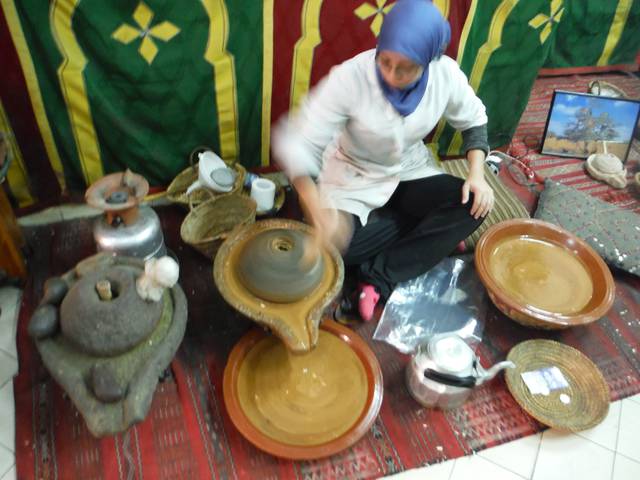 Marrakech is home to a large tanning industry, and leather goods of high quality can be bought here cheaply. Check out camel leather items especially - jackets, round poufs (little ottomans), and handbags.
Marrakech is home to a large tanning industry, and leather goods of high quality can be bought here cheaply. Check out camel leather items especially - jackets, round poufs (little ottomans), and handbags.
For the shoes, always check they have no paper inside sole because it is very common. Do not be fooled by demonstration of bending the shoe back and forth; try it yourself by feeling and hearing how the paper bends. For poor quality shoes you should not pay more than 40 dirham, and for a good pair no more than 90 dirham. Shop around and learn the difference in shoe quality.
Also of interest would be items made of the local cactus silk, which is really rayon, a natural fiber made of plant cellulose and produced in Morocco. Rayon holds the chemical dyes well which accounts for the vibrant range of true colors (natural dyes cannot produce a "true" color). On offer are scarves, handbags, tablecloths, bedspreads and throws in stunning colors. Some merchants try to charge a premium price for this "cactus silk". Check well because there are many fakes and sellers will usually tell you any lie to get you to pay a high price.
Be sure to wander around the potters' souk, and look for brightly colored platters and bowls, as well as tagines (large, lidded cookpots) in all sizes
Lovely cashmere shawls can also be had for less than a fiver with a little bargaining.
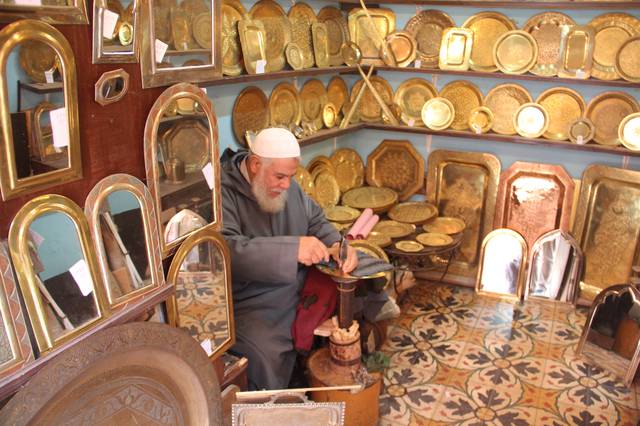
If you cannot stand the bargaining, there are two government-run shops where you can buy handicrafts at fixed prices. Look for boutique d'artisans. One is near Djemaa El-Fna while the other one is in the ville nouvelle.
- Les établissements Bouchaïb, 7, Derb Baïssi Kasbah Boutouil (on Rue de La Kasbah, +212 524381853. Huge two-story store with fixed prices. Carpets, spices, argon oil, jewelry, ceramics, furniture, wood handcrafts, etc. Check out the prices on the webpage before you go to get and idea of the cost of the items you are interested in.
An option to explore the souks in a more tranquil way is to go during the Friday prayer. Although some shops will be closed, most stay open and are significantly less crowded than at other times.
The Apple and Samsung smartphones being sold on Djemaa El-Fna are Chinese-built fakes; they work fine but employ less storage and cheaper components than the originals. Bargain accordingly.
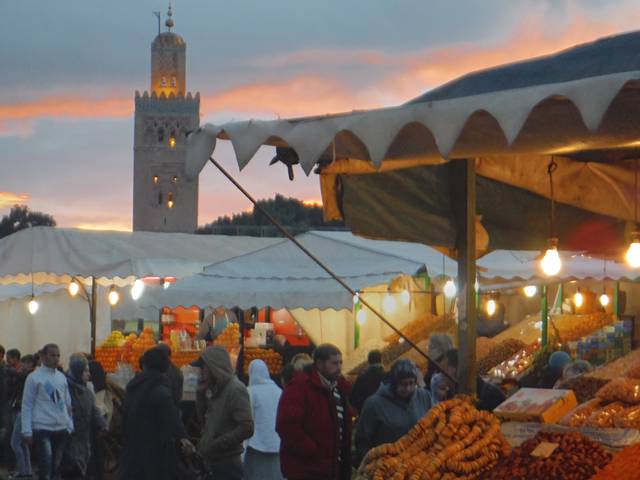
- Chez Monseur Michelin, 83 Riad Zitoun. Handmade bags and fashion items made from recycled tires and inner tubes.
- Faissal, 119 Rue Mouassine (next to Maison de la Photographie, +212 696972001. Tiny workshop making scarves in wool, cotton, and linen.
As a guide for prices, maximum and generous prices you should pay.
- Djellaba, long coat with hood for men, made of cotton/wool. Low quality: 90 dirham. Good (thick) quality: 300 dirham.
- Paintings, depends on the quality and size but no more than 50 dirham for a 70x50cm.
- Shisha, 150 dirham for the smallest ones. Prices then vary with size and quality.
- Tobacco for shisha, 20 dirham. There are many flavours and decent prices at the duty-free store at the airport in Marrakech.
- Shoes, for home, no more than 50 dirham for a good one, for the street no more than 90 dirham for a good quality one.
- Lamp, no more than 60 dirham for a medium size lamp.
- Woven beanie, 15 dirham.
- T-shirt, no more than 50 dirham for a large.
- Small wooden snake toys, 5 dirham.
- Small teapot (2-3 cups), 90-100 dirham.
- Medium size cooking tagine 40 dirham. (Choose carefully, glazed tagines have a risk of releasing unsafe levels of lead.)
- Dress for women, poor quality, not wool, 30 dirham.
- Carpets: 1,000 dirham for a white wool carpet that is 8 ft x 12 ft
- Henna tattoo: medium-sized design should cost no more than 50 dirham (Ask for brown henna if you are allergic to PPP black henna, the brown henna is natural and safe)
- You can order special gold jewellery items like a chain with your name on it or using a customised design but ensure you have agreed on the price beforehand.
- 250 g of gunpowder tea, 30 dirham. Although best bought at a supermarket.
- Round piece of bread, 1.5 dirham.
- Spice mixes, 80 dirham/kg. Cumin, curcuma, cinnamon, ground ginger, etc. 40-60 dirham/kg
Also see Morocco#Buy. Do not offer a price that you are not willing to pay. Even hostel prices can be haggled.
Remember, sellers are just the middle man, they do not produce it, except maybe for some kinds of lamps, and they pay very little to the people who actually make it. Also, never pay in advance. And never let anyone write you an invoice. It is a bad idea and in most of the cases you will never see your goods or money back.
Most major banks and a slew of cash exchange shops can be found in a cluster around Arset el bilk (next to the main square). Most banks don't accept Unionpay and many ATMs displaying the Unionpay logo actually don't support the cards regardless of what Unionpay or the bank's website will tell you. Apparently the Société Générale banks can do withdrawals from 16:00-21:00.
Be aware that if you are shopping at western stores like Zara, that the return policies are different. Contrary to many other countries, purchases by credit card can only be exchanged, not returned. Cash purchases at these stores can be returned for a refund however.
Les établissements Bouchaïb, 7, Derb Baïssi Kasbah Boutouil (on Rue de La Kasbah, +212 524381853. Huge two-story store with fixed prices. Carpets, spices, argon oil, jewelry, ceramics, furniture, wood handcrafts, etc. Check out the prices on the webpage before you go to get and idea of the cost of the items you are interested in.
Chez Monseur Michelin, 83 Riad Zitoun. Handmade bags and fashion items made from recycled tires and inner tubes.
Faissal, 119 Rue Mouassine (next to Maison de la Photographie, +212 696972001. Tiny workshop making scarves in wool, cotton, and linen.
- 16 Café. Moroccan kitchen. 16 café is caterer of events and weddings.
- Café Alhamra, +212 6504 7411. Place Djemaa El-Fna, opposite Café de France. On the edge of the square, it serves up salads, pizza, and pasta as well as a tagine of the day. Their rooftop is a good place to have a late night coffee and pastry while watching the events in the square below.
- Café Arabe, 184 mouassine (medina near dar el bacha, +212 2442 9728. They have a Moroccan and an Italian cook, so there are two menus to choose from. There are three floors including the downstairs courtyard which is lovely for lunch. The top floor terrace has fantastic views, you can lounge on their sofas sipping a cocktail and watching the sun go down over the medina.
- Café Mabrouk. Serves the same standard fare as everywhere else in a little courtyard or terrace.
- Café Restaurant Argana, +212 5244-45350. Daily 06:00-23:00. A tourist hot-spot overlooking the square with excellent Moroccan dishes and ice creams.
- Chez Chegrouni. Their vegetarian couscous is supposedly the only true vegetarian couscous in town; it's also bland but they give you plenty of it. Prices go up if you sit on the terrace. Usually packed full of good-time tourists. 30 dirham.
- Chez El Bahia, 206 Rue Riad Zitoune (50m SE from Djemaa El-Fna on Rue Riad Zitoune (that starts at Wafa Restaurant). It is a quiet place. Try the chicken and olives tajine as well as the prune, almonds, and mutton tajine. Also try the Moroccan salad while they cook the rest of the food. about 100 dirham.
- Chez Yassine, 70 Avenue Fatima Zohra (5 min north from the Koutoubia mosque, 70 Rue Fatima Zohra Rmila (next to the Bacha hamam). Not much choice but served by very friendly people. Tajines and pizzas are great and you can also order skewers that are not on the menu. 30 dirham tagines.
- Diaffa, Rue Jbel El Akhdar (just off Av. Mohammed V, across from Club Med, +212 44 38 68 98. An upscale restaurant in one of the oldest buildings in the Medina, and offers Moroccan cuisine in an ambiance that recalls the Orient at the height of its magic and glory. The food, building (whether the tables around the central courtyard and fountain or the second-level balcony), and tactful and tasteful entertainment.
- Earth Cafe, Number 2, Derb Zawak, Riad Zitoun Kedim (in the Medina, +212 6054 4992, +212 6128 9402. Vegetarian-friendly. Also available are vegan alternatives and plenty of options for fruit and vegetable-based drinks.
- Henna Cafe, 93 Arset Aouzal Souikat, bab Doukala (go to the taxi rank at Dar El Basha and walk 100 m up towards Bab Doukala. Henna Café is on the right side, +212 656566374. 11:00-20:00. If you want to travel ethically then this is your place. A pretty little cafe on 3 floors with an orange sign on the berber hand-carved wooden facade opened in November 2011. You can have a cup of tea or coffee or simple lunch with dessert or just a sandwich. The Henna Café offers safe henna body adornment as well-ranging from a 50 dirham small motif on your hand to a full arm complex design for a wedding from 500 dirham. All profits go to local causes. Henna cafe was set up by the owners of Riad Cinnamon and Riad Papillon and Vivid Trading in order to start to 'give back' to Marrakech and offer support to those who might want it. The café offers free English lessons to Moroccan women so that they can find employment out of the home. 40 dirham mains.
- Maison de la Photographie, 46, Rue souk Ahal Fès (200 m behind Ben Youssef Medersa - Koranic School. A little photography museum, it has one of the highest roof terraces in the Medina. Over lunch of a fixed-price menu (at 75 dirham as of 2012) you get panoramic views over the city and the High Atlas mountains.
- Le Marrakchi. With two main courses and wine running at around 300 dirham, this is one of the poshest restaurants in the square. The food is not necessarily better than elsewhere, but it is one of the few restaurants that serves alcohol. It also has a completely enclosed upstairs terrace, which is ideal for views of the square when the weather is bad.
16 Café. Moroccan kitchen. 16 café is caterer of events and weddings.
Café Alhamra, +212 6504 7411. Place Djemaa El-Fna, opposite Café de France. On the edge of the square, it serves up salads, pizza, and pasta as well as a tagine of the day. Their rooftop is a good place to have a late night coffee and pastry while watching the events in the square below.
Café Arabe, 184 mouassine (medina near dar el bacha, +212 2442 9728. They have a Moroccan and an Italian cook, so there are two menus to choose from. There are three floors including the downstairs courtyard which is lovely for lunch. The top floor terrace has fantastic views, you can lounge on their sofas sipping a cocktail and watching the sun go down over the medina.
Café Mabrouk. Serves the same standard fare as everywhere else in a little courtyard or terrace.
Café Restaurant Argana, +212 5244-45350. Daily 06:00-23:00. A tourist hot-spot overlooking the square with excellent Moroccan dishes and ice creams.
Chez Chegrouni. Their vegetarian couscous is supposedly the only true vegetarian couscous in town; it's also bland but they give you plenty of it. Prices go up if you sit on the terrace. Usually packed full of good-time tourists. 30 dirham.
Chez El Bahia, 206 Rue Riad Zitoune (50m SE from Djemaa El-Fna on Rue Riad Zitoune (that starts at Wafa Restaurant). It is a quiet place. Try the chicken and olives tajine as well as the prune, almonds, and mutton tajine. Also try the Moroccan salad while they cook the rest of the food. about 100 dirham.
Chez Yassine, 70 Avenue Fatima Zohra (5 min north from the Koutoubia mosque, 70 Rue Fatima Zohra Rmila (next to the Bacha hamam). Not much choice but served by very friendly people. Tajines and pizzas are great and you can also order skewers that are not on the menu. 30 dirham tagines.
Diaffa, Rue Jbel El Akhdar (just off Av. Mohammed V, across from Club Med, +212 44 38 68 98. An upscale restaurant in one of the oldest buildings in the Medina, and offers Moroccan cuisine in an ambiance that recalls the Orient at the height of its magic and glory. The food, building (whether the tables around the central courtyard and fountain or the second-level balcony), and tactful and tasteful entertainment.
Earth Cafe, Number 2, Derb Zawak, Riad Zitoun Kedim (in the Medina, +212 6054 4992, +212 6128 9402. Vegetarian-friendly. Also available are vegan alternatives and plenty of options for fruit and vegetable-based drinks.
Henna Cafe, 93 Arset Aouzal Souikat, bab Doukala (go to the taxi rank at Dar El Basha and walk 100 m up towards Bab Doukala. Henna Café is on the right side, +212 656566374. 11:00-20:00. If you want to travel ethically then this is your place. A pretty little cafe on 3 floors with an orange sign on the berber hand-carved wooden facade opened in November 2011. You can have a cup of tea or coffee or simple lunch with dessert or just a sandwich. The Henna Café offers safe henna body adornment as well-ranging from a 50 dirham small motif on your hand to a full arm complex design for a wedding from 500 dirham. All profits go to local causes. Henna cafe was set up by the owners of Riad Cinnamon and Riad Papillon and Vivid Trading in order to start to 'give back' to Marrakech and offer support to those who might want it. The café offers free English lessons to Moroccan women so that they can find employment out of the home. 40 dirham mains.
Maison de la Photographie, 46, Rue souk Ahal Fès (200 m behind Ben Youssef Medersa - Koranic School. A little photography museum, it has one of the highest roof terraces in the Medina. Over lunch of a fixed-price menu (at 75 dirham as of 2012) you get panoramic views over the city and the [[High Atlas]] mountains.
Le Marrakchi. With two main courses and wine running at around 300 dirham, this is one of the poshest restaurants in the square. The food is not necessarily better than elsewhere, but it is one of the few restaurants that serves alcohol. It also has a completely enclosed upstairs terrace, which is ideal for views of the square when the weather is bad.
For more upscale eateries (and especially for non-Moroccan cuisine) you generally must go outside the Medina to Ville Nouvelle.
- Al Fassia, 55, boulevard Zerktouni, +212 524 43 40 60. W-M. Traditional Moroccan food in cozy restaurant run by women (except the doorman). Wine served by the bottle.
- Associacion Amal, +212-5-24-44-68-96. Lunch: daily 12:00-16:00, dinner: groups of min. 10 people by reservation only. Here you can experience lunch similar to what Moroccans eat at home: this women's aid association provides women with education in exchange for food which is then sold for financing the model.
- Café du Livre, 44 Rue Tariq Bnou Ziad, Guéliz (located near Place du 16 Novembre, Rue Tariq Bnou Ziad is more or less parallel to Ave Mohamed V (to the East), the Hotel is located between the crossroads with Rue de la Liberté and Rue Sourya, +212 5244-46921. 09:30-21:00. A western style bookshop-café in the villa nouvelle medium priced, sandwiches ~ 40–60 dirham.
- Café Kabash, 47 Boutouil, Kasbah (on Rue Kashbah near Bab Agnaou, +212 524 382 625. Have a roof terrace with a good view. Daily moroccan menus with tea and juice.
- Dar Najat's Kitchen, Douar Groua, derb lalla chacha, N.18 (5 min walk from Jeema el Fna, +212 524375085. Daily fresh food in a boutique riad. €23 per person.
- El Bahriya, +212 766778172. A great fish restaurant, where you choose you fish (prawn, salmon, calamari, lobster, etc.) and pay per kg. The fish is then grilled and served with various side dishes, but you only pay for the fish (and the tea). Do not drink the water, which is also put onto the table and invoiced. 170-300 dirham per kg.
- Le Bistrot Loft, 18 Rue de la Liberté, +212 524 434 216. Steaks, bistro food and good wines. Bar with beer, aperitifs and cocktails. 200 dirham.
- Pepe Nero, 17, Derb Cherkaoui, Douar Graoua (follow the signs from Rue Zitoun El Jedid; note the metal arrows, +212 524 389067. Tu-Su 12:00-14:30, 19:30-23:00. Fine Italian and Moroccan dining in gorgeous Riad. Often full so make a reservation. 400 dirham for 3-4 course dinner, wine for 200 dirham.
- Riad des Mers, 413 Derb Sidi Massoud (inside Bab Yacout, +212 662265030. Seafood restaurant. No alcohol served. 300 dirham menu.
Al Fassia, 55, boulevard Zerktouni, +212 524 43 40 60. W-M. Traditional Moroccan food in cozy restaurant run by women (except the doorman). Wine served by the bottle.
Associacion Amal, +212-5-24-44-68-96. Lunch: daily 12:00-16:00, dinner: groups of min. 10 people by reservation only. Here you can experience lunch similar to what Moroccans eat at home: this women's aid association provides women with education in exchange for food which is then sold for financing the model.
Café du Livre, 44 Rue Tariq Bnou Ziad, Guéliz (located near Place du 16 Novembre, Rue Tariq Bnou Ziad is more or less parallel to Ave Mohamed V (to the East), the Hotel is located between the crossroads with Rue de la Liberté and Rue Sourya, +212 5244-46921. 09:30-21:00. A western style bookshop-café in the villa nouvelle medium priced, sandwiches ~ 40–60 dirham.
Café Kabash, 47 Boutouil, Kasbah (on Rue Kashbah near Bab Agnaou, +212 524 382 625. Have a roof terrace with a good view. Daily moroccan menus with tea and juice.
Dar Najat's Kitchen, Douar Groua, derb lalla chacha, N.18 (5 min walk from Jeema el Fna, +212 524375085. Daily fresh food in a boutique riad. €23 per person.
El Bahriya, +212 766778172. A great fish restaurant, where you choose you fish (prawn, salmon, calamari, lobster, etc.) and pay per kg. The fish is then grilled and served with various side dishes, but you only pay for the fish (and the tea). Do not drink the water, which is also put onto the table and invoiced. 170-300 dirham per kg.
Le Bistrot Loft, 18 Rue de la Liberté, +212 524 434 216. Steaks, bistro food and good wines. Bar with beer, aperitifs and cocktails. 200 dirham.
Pepe Nero, 17, Derb Cherkaoui, Douar Graoua (follow the signs from Rue Zitoun El Jedid; note the metal arrows, +212 524 389067. Tu-Su 12:00-14:30, 19:30-23:00. Fine Italian and Moroccan dining in gorgeous Riad. Often full so make a reservation. 400 dirham for 3-4 course dinner, wine for 200 dirham.
Riad des Mers, 413 Derb Sidi Massoud (inside Bab Yacout, +212 662265030. Seafood restaurant. No alcohol served. 300 dirham menu.
- La Villa des Orangers, Rue Sidi Mimoune 6, +212 524 384638. 19:30-late. French gastronomic cuisine in a very calm and pleasant atmosphere. Enjoy your dinner in soft chairs, among dark woodpanels, bookcases and artwork. In the winter start with a drink at the fireplace. 700 dirham for three-course menu. 500 dirham for a bottle of wine..
- Le Grand Café de la Poste, Boulevard El mansour Eddahbi and Avenue Imam Malik, +212 24 43 30 38. French brasserie with Moroccan influence in the former post office. 300 dirham for three courses..
- Le Grand Salon, Djnan Abiad, La Palmeraie B.P. 12478 (in the Ksar Char-Bagh outside of the city, +212 524 32 92 44. Upscale restaurant with French cuisine. Serve organic vegetables and olive oil from its own gardens. 600 dirham for three courses.
- Dar Yacout, 79, derb Sidi Ahmed Soussi, Bab Doukkala, +212 5 24 38 29 29. Traditional Moroccan gastronomic cuisine. Has a terrace overlooking the Medina. 700 dirham menu.
- Le Foundouk, Rue Souk Hal Fassi, +212 5 24 37 81 76. Tu-Su. Moroccan and European cuisine. Roof terrace and bar. 300 dirham for a three-course dinner.
- Les Jardins de la Medina, 21 Derb Chtouka (in the hotel of the same name, +212 5 24 381 851. 19:30-late. Traditional and modern Moroccan cuisine. Moroccan wine served by bottle and glass. Stylish restaurant with tall white columns. 450 dirham menu.
La Villa des Orangers, Rue Sidi Mimoune 6, +212 524 384638. 19:30-late. French gastronomic cuisine in a very calm and pleasant atmosphere. Enjoy your dinner in soft chairs, among dark woodpanels, bookcases and artwork. In the winter start with a drink at the fireplace. 700 dirham for three-course menu. 500 dirham for a bottle of wine..
Le Grand Café de la Poste, Boulevard El mansour Eddahbi and Avenue Imam Malik, +212 24 43 30 38. French brasserie with Moroccan influence in the former post office. 300 dirham for three courses..
Le Grand Salon, Djnan Abiad, La Palmeraie B.P. 12478 (in the Ksar Char-Bagh outside of the city, +212 524 32 92 44. Upscale restaurant with French cuisine. Serve organic vegetables and olive oil from its own gardens. 600 dirham for three courses.
Dar Yacout, 79, derb Sidi Ahmed Soussi, Bab Doukkala, +212 5 24 38 29 29. Traditional Moroccan gastronomic cuisine. Has a terrace overlooking the Medina. 700 dirham menu.
Le Foundouk, Rue Souk Hal Fassi, +212 5 24 37 81 76. Tu-Su. Moroccan and European cuisine. Roof terrace and bar. 300 dirham for a three-course dinner.
Les Jardins de la Medina, 21 Derb Chtouka (in the hotel of the same name, +212 5 24 381 851. 19:30-late. Traditional and modern Moroccan cuisine. Moroccan wine served by bottle and glass. Stylish restaurant with tall white columns. 450 dirham menu.
-uQHda.medium.jpg)
Each night in the Djemaa El-Fna rows of street stalls are set up under giant white tents. The huts targeting tourists serve similar fare and have menus printed in French, Arabic and usually English. Everyone has tajine, couscous, brochette and some variety of soups. Some have specialities like offal, egg sandwiches or special tajines. Be aware that most restaurants employ rather insistent "greeters," who are very aggressive in trying to customers for their stall. The line 'we already ate' seems to work well to get them to stop. As of 2018, the "greeters" mentioned above have changed strategies to one of harassment and insults. They try to separate couples and corner women while hurling insults.
If you want to eat well in Marrakech, do what the locals do and eat at the food stalls in the square. It is a common misconception that these stalls are only here for the tourists. Actually, they have been in existence long before Marrakech became a tourist destination. All of the stalls can be regarded as perfectly safe to eat at. They are strictly licensed and controlled by the government, especially now as it is a popular destination for tourists. The locals eat at the cheaper stalls that don't employ greeters and serve the more interesting food: snails, sheep head, lentils and beans.
Some tips:
- Prices tend to vary a little. Depending upon how hungry you are, you can pay anything from 10 dirham for a bread filled with freshly grilled sausages, or perhaps a bowl of harira soup to 100 dirham for a full three-course meal with salad, bread, starter, main course, and tea.
- Try harira (great soup, of lamb/beef, red lentils and vegetables) and the fried aubergines. Don't be afraid-try the lamb head: it's really tasty. The "bull stew" (beef stew) should also be given a chance in the same stalls.
- Don't miss the tea! There is a row of tea sellers along the front of the food stalls who each sell tea for 3 dirham each (as of 2011). Most of the tea at these stalls is actually ginseng tea with cinnamon and ginger... most delicious and welcoming. They also have cake, made of basically the same spices, which can be a bit overpowering.
- All food stalls at Djemaa El-Fna display the price on the menus, making it less likely you'll be overcharged, but many will bring starters to you without asking, then charge for them at the end.
- Drinks are rarely on the menu so it is better to ask the price of them before ordering, as they can often be comparatively high. On the other hand, some stalls offer free mint tea to encourage you to choose them.
- Early mornings, look for people frying riifa in the covered part opposite the Koutoubia. Riifa is dough stretched and flattened and folded over, then cooked in a frying pan, and is best described as a Moroccan version of a pancake or crepe.
Street vendors offer fresh orange juice (jus d'Orange) by the glass for 4 dirham. Try it with a dash of salt like the locals, but be wary of vendors who try and water the juice down with tap water. Also, pay attention when you buy as they offer 2 types of orange... the blood orange juice costs 10 dirham per glass and a misunderstanding on what you want to drink could occur.
Confirm the price of your orange juice and pay for it before you drink. Unscrupulous vendors will sometimes try to charge you 10 dirham for a 4-dirham glass of jus d'Orange, so don't accept your drink until you've paid the correct amount.
Be wary also, that they do not always clean the glasses very well so it is possible to get an upset stomach from the juice.
There is a very limited selection of places selling alcohol in the Medina.
- Chesterfield Pub, 115 Avenue Mohammed V (In the Hotel Nassim. 09:00-01:00. A slightly unusual experience, apparently an 'English pub' it serves Moroccan lager and has an outside pool in a courtyard with palm trees, not an entirely English experience. Much less touristy than it sounds with a mainly local clientele. It serves a decent pint.
- Le Salama, 40 Rue des Banques (On Jeema El Fna, facing Cafe de France, take the road to the left of Café de France (as in walking behind it). After 100 m on the left hand side.. 11:00-13:00. Happy hour from 17:00 until they close, mostly western pop classics on the top floor. Very touristy with shishas, belly dancing and waiters who wear a fez - none of it is typically Moroccan but the overall atmosphere is between relaxed and party vibe. Also offers traditional Moroccan snacks. Good for smaller (up to 10 people) groups.
- Hotel Grand Tazi, Rue Bab Agnaou. The hotel has a public bar, serving beer and wine and is not overly expensive.
- Narwama, Hay Zefriti 30, Rue Koutoubia., +212 6 7250 8700. Restaurant and bar that has a fire fountain in the centre and an open roof around the patio. The atmosphere is very chilled and their food is very good, but slightly expensive. Good for pre-dinner drinks. 150 dirham mains.
Outside the Medina.
- Montecristo, Rue Ibn Aicha 20, +212 5 24439031. 20:00-02:00. Nightclub with rooftop terrace
- Jad Mahal, 10 Rue Haroun Errachid, +212 5 24 43 69 84. 17:00-late. Lounge bar and formal restaurant.
- Sky Lounge, 3 Rue du Temple (at The Pearl Hotel, +212 524 42 42 42. 11:00-late. Fashionable rooftop lounge on top of the Pearl Hotel
- Comptoir Darna, Avenue Echouhada, +212 524 437 702. 20:00-03:00. Cocktail bar and night club Dress code: elegant
- Piano Bar, 26 Rue de la Koutoubia (in les Jardins de la Koutoubia, +212 024 38 88 00. 17:00-midnight.
- African Chic, 6 Rue Oum Errabia (Behind Hotel Marrakech, +212 5 24431424. Moroccan Latin Brazilian. Also has a restaurant with a view to the dance floor.
- Le Lounge, 24 Rue Yougoslavie, +212 70028561. 10:00-01:00.
Chesterfield Pub, 115 Avenue Mohammed V (In the Hotel Nassim. 09:00-01:00. A slightly unusual experience, apparently an 'English pub' it serves Moroccan lager and has an outside pool in a courtyard with palm trees, not an entirely English experience. Much less touristy than it sounds with a mainly local clientele. It serves a decent pint.
Le Salama, 40 Rue des Banques (On Jeema El Fna, facing Cafe de France, take the road to the left of Café de France (as in walking behind it). After 100 m on the left hand side.. 11:00-13:00. Happy hour from 17:00 until they close, mostly western pop classics on the top floor. Very touristy with shishas, belly dancing and waiters who wear a fez - none of it is typically Moroccan but the overall atmosphere is between relaxed and party vibe. Also offers traditional Moroccan snacks. Good for smaller (up to 10 people) groups.
Hotel Grand Tazi, Rue Bab Agnaou. The hotel has a public bar, serving beer and wine and is not overly expensive.
Narwama, Hay Zefriti 30, Rue Koutoubia., +212 6 7250 8700. Restaurant and bar that has a fire fountain in the centre and an open roof around the patio. The atmosphere is very chilled and their food is very good, but slightly expensive. Good for pre-dinner drinks. 150 dirham mains.
Montecristo, Rue Ibn Aicha 20, +212 5 24439031. 20:00-02:00. Nightclub with rooftop terrace
Jad Mahal, 10 Rue Haroun Errachid, +212 5 24 43 69 84. 17:00-late. Lounge bar and formal restaurant.
Sky Lounge, 3 Rue du Temple (at The Pearl Hotel, +212 524 42 42 42. 11:00-late. Fashionable rooftop lounge on top of the Pearl Hotel
Comptoir Darna, Avenue Echouhada, +212 524 437 702. 20:00-03:00. Cocktail bar and night club Dress code: elegant
Piano Bar, 26 Rue de la Koutoubia (in les Jardins de la Koutoubia, +212 024 38 88 00. 17:00-midnight.
African Chic, 6 Rue Oum Errabia (Behind Hotel Marrakech, +212 5 24431424. Moroccan Latin Brazilian. Also has a restaurant with a view to the dance floor.
Le Lounge, 24 Rue Yougoslavie, +212 70028561. 10:00-01:00.
There are many dry cleaning shops inside and outside of the Medina. It takes only one day to clean and will cost from 10-30 dirham per piece. If you stay at hotel, you can hand out your dirty clothes to a housekeeper. Usually they wash it by hand. They do not have a price list and usually say "up to you". You should not pay more than 50-100 dirham per plastic bag.
- Lost in Marrakech Laundry Service, 156 Derb Snane, Mouassine, Medina, +212 5 2438 4121. M-Sa 09:00-16:00. Laundromat with used books, wifi, coffee and smoothies. Finish in same day or in next day. 20 dirham for 2 kg.
Be sure to report any crime to both the local police and your embassy.
- British Honorary Consulate in Marrakech, Résidence Taib 55, Boulevard Zerktouni, Gueliz, +212 5 2442 0846. M-F 08:00-13:00.
Most other foreign embassies and consulates in Morocco are in Rabat, with a few more in Casablanca.
British Honorary Consulate in Marrakech, Résidence Taib 55, Boulevard Zerktouni, Gueliz, +212 5 2442 0846. M-F 08:00-13:00.
Lost in Marrakech Laundry Service, 156 Derb Snane, Mouassine, Medina, +212 5 2438 4121. M-Sa 09:00-16:00. Laundromat with used books, wifi, coffee and smoothies. Finish in same day or in next day. 20 dirham for 2 kg.
Marrakech is a generally safe city, with a solid police presence. However, staying alert about your surroundings and taking general safety precautions is always a good idea like everywhere. Here are some tips:
- Violent crime is normally not a major problem, but thefts are known to happen. Keep your money close and hidden, and avoid poorly lit streets or alleys at night.
- Guides offering their services should display an official badge from the local tourist authorities.
- Morocco is under an increased threat from international terrorism. Be vigilant when you're out and contact authorities if you notice anything suspicious.
- Be especially careful about being drugged, especially as a solo traveller. The common and easy-to-make drug GHB only lasts three hours and is undetectable in the body after 7 hours, so if you are attacked, take action immediately.
- Be careful ordering room service if you are a solo traveller, as even older women can be targets for robbery. Don't ask the waiter to enter your room.
- Get one of the shopkeepers to dress you up with a berber style scarf, for men and women, it will cover your face (leaving only space for your eyes) and you can remain undetected and will definitely not be harassed by the shopkeepers, one or two beggars may catch on that you are still a tourist from the way you are dressed though, so bear that in mind.
- Police, 19.
- Ambulance/ Fire, 15.
Police, 19.
Ambulance/ Fire, 15.
- Inb Tofail Hospital, Rue Abdelouahab Derraq, +212 4444 8011.
- Polyclinique du Sud, 2 Rue Yougoslavie, Gueliz, +212 4444 7999, +212 4444 8372. In case of a medical emergency, it's always a good idea to know where to find the local physicians who speak your language. According to the U.S. Consulate website, Dr. Taarji Bel Abbass at the Polyclinique du Sud speaks "fair to good English".
Inb Tofail Hospital, Rue Abdelouahab Derraq, +212 4444 8011.
Polyclinique du Sud, 2 Rue Yougoslavie, Gueliz, +212 4444 7999, +212 4444 8372. In case of a medical emergency, it's always a good idea to know where to find the local physicians who speak your language. According to the U.S. Consulate website, Dr. Taarji Bel Abbass at the Polyclinique du Sud speaks "fair to good English".
The tap water in Marrakech is suitable for bathing. While locals drink it with no problems, visitors often find it hard to digest. To be safe, opt for bottled mineral water, available at the numerous marketplace kiosks and food stalls. Make sure that the cap seal has not been broken, since vendors have been known to save money by refilling plastic bottles from the tap. At restaurants, ask for your drinks without ice, which are usually made with tap water.
A Moroccan idiom is "Marrakech, Arnakech" ("Marrakech is Mafia"): Marrakech is the city with the most inflated prices, the most persistent touts and the most cunning scammers. Even Moroccans who visit Marrakech complain. So all the warnings listed on main page about Morocco should be taken extra seriously. On the plus side, at least since September 2016 (and still valid in April 2017), police has been cleaning up a lot; so take these items with a grain of salt and keep an open mind:
- "It's closed": This is a common technique by scammers pretending to be tourist guides. Some will even have printed badges with photos and documents pretending to be from the Ministry of Tourism. They will ask you or guess where you are going and say that it's closed. Immediately after or later in the conversation, they will lure you to the location they want you to go, usually some sort of commerce with inflated prices. If a random stranger approaches you and claims a location of interest is closed, it is very likely a scam.
- "Only every 15 days": Another technique is to say a group of Berber only comes every 15 days to do commerce. Buy now, or miss the opportunity!
- Directions then pay: If strangers are showing you the way and following you, they may ask you for money at the end of showing directions.
- Snake charmers: Stay at a distance unless willing to pay 20 dirham. They will put a snake around your neck for picture and expect payment.
- Taxi drivers in the "tourist hot spots" (train station, gare routiere, agence CTM, Djeema El-Fna), by default, do not use the meter, though they have to by law, and they overcharge a lot: Either insist on the meter (good luck with that) or agree on a flat price up front. By meter, the trip from the train station to Djeema El-Fna is 13 dirham during daytime, a flat price of 20 dirham is a good deal for a tourist, regular asking price is 50 to 70 dirham! If your luggage permits, just walking 100 m down the street, away from the "tourist hot spot", and hailing a taxi will get you a much saner deal (or even a metered fare).
- Djeema El-Fna is now heavily patrolled by tourist police and one can actually walk there pretty much hassle free, except for: At night time, the food stalls can be pretty "aggressive" when trying to convince you to eat there. "Aggressive" as in shoving the menu into your face, while blocking your path or grabbing your hand because they are sure you are an "old friend", starting a lengthy, friendly conversation. And they still try the "complimentary XY" trick where they'll serve you spoonfuls of fries, salads or other items while you are already eating - each tiny plate shows up as 5 dirham on the bill. The latter can be easily avoided by insisting on paying immediately when your food arrives and then just walking away after you finished your meal. On the plus side: With all the tourist police present (April 2017) simply raising your voice when telling the same guy "la, shokran!" (no, thank you!) for the 3rd time or when debating a bill that lists items you did not order will probably make them stop for fear of police intervention.
- When ignoring touts, you might get dismissive remarks shouted after you, usually tailored to your (guessed) nationality: Unless you know at least French really well, just keep on ignoring them.
- When you get lost in the Medina, you should never have to pay more than 20 dirham to a random person to get you at least out of the medina to a taxi that can drop you of someplace from which you can navigate. Again, agree on a price upfront and have the exact amount ready (or change en route in some shop).
- Henna tattoos are popular with locals and tourists alike. But among the many genuine traders are some scam artists who offer a free henna tattoo only to charge ridiculous prices afterwards (up to 10 times as much as locals would have to pay). Simply refuse any "free" henna tattoos. And, in Marrakech more than in other places, be wary of overly good henna: It is probably regular, cheap henna, mixed with chemicals like PPD to make it appear darker (i.e. of higher quality). This is not only questionable from an overall health perspective but it can lead to serious allergic reactions.
Always remember: Most Moroccans are incredibly friendly, honest people, so sometimes making a fuss in public can generate unwanted attention for a scam artist and shame them into backing off.
"It's closed": This is a common technique by scammers pretending to be tourist guides. Some will even have printed badges with photos and documents pretending to be from the Ministry of Tourism. They will ask you or guess where you are going and say that it's closed. Immediately after or later in the conversation, they will lure you to the location they want you to go, usually some sort of commerce with inflated prices. If a random stranger approaches you and claims a location of interest is closed, it is very likely a scam.
"Only every 15 days": Another technique is to say a group of Berber only comes every 15 days to do commerce. Buy now, or miss the opportunity!
Directions then pay: If strangers are showing you the way and following you, they may ask you for money at the end of showing directions.
Snake charmers: Stay at a distance unless willing to pay 20 dirham. They will put a snake around your neck for picture and expect payment.
Taxi drivers in the "tourist hot spots" (train station, gare routiere, agence CTM, Djeema El-Fna), by default, do not use the meter, though they have to by law, and they overcharge a lot: Either insist on the meter (good luck with that) or agree on a flat price up front. By meter, the trip from the train station to Djeema El-Fna is 13 dirham during daytime, a flat price of 20 dirham is a good deal for a tourist, regular asking price is 50 to 70 dirham! If your luggage permits, just walking 100 m down the street, away from the "tourist hot spot", and hailing a taxi will get you a much saner deal (or even a metered fare).
Djeema El-Fna is now heavily patrolled by tourist police and one can actually walk there pretty much hassle free, except for: At night time, the food stalls can be pretty "aggressive" when trying to convince you to eat there. "Aggressive" as in shoving the menu into your face, while blocking your path or grabbing your hand because they are sure you are an "old friend", starting a lengthy, friendly conversation. And they still try the "complimentary XY" trick where they'll serve you spoonfuls of fries, salads or other items while you are already eating - each tiny plate shows up as 5 dirham on the bill. The latter can be easily avoided by insisting on paying immediately when your food arrives and then just walking away after you finished your meal. On the plus side: With all the tourist police present (April 2017) simply raising your voice when telling the same guy "la, shokran!" (no, thank you!) for the 3rd time or when debating a bill that lists items you did not order will probably make them stop for fear of police intervention.
When ignoring touts, you might get dismissive remarks shouted after you, usually tailored to your (guessed) nationality: Unless you know at least French really well, just keep on ignoring them.
When you get lost in the Medina, you should never have to pay more than 20 dirham to a random person to get you at least out of the medina to a taxi that can drop you of someplace from which you can navigate. Again, agree on a price upfront and have the exact amount ready (or change en route in some shop).
Henna tattoos are popular with locals and tourists alike. But among the many genuine traders are some scam artists who offer a free henna tattoo only to charge ridiculous prices afterwards (up to 10 times as much as locals would have to pay). Simply refuse any "free" henna tattoos. And, in Marrakech more than in other places, be wary of overly good henna: It is probably regular, cheap henna, mixed with chemicals like PPD to make it appear darker (i.e. of higher quality). This is not only questionable from an overall health perspective but it can lead to serious allergic reactions.
Be especially careful about being drugged, especially as a solo traveller. The common and easy-to-make drug GHB only lasts three hours and is undetectable in the body after 7 hours, so if you are attacked, take action immediately.

Marrakech can make a good base for exploring the High Atlas or for organizing one to four day Sahara treks. The following are towns in the High Atlas that can be seen as part of a day trip:
- Amizmiz. With one of the largest Berber souks in the High Atlas Mountains every Tuesday, Amizmiz is well-worth a trip. This is especially true for those travellers wishing to experience the less urban, less touristy mountain towns of the High Atlas. The souk itself deals mostly in the ordinary household goods that any Walmart does; plan your souvenir shopping elsewhere.
- Asni. A lovely rural village in the Atlas mountains.
- Essaouira. Charming coastal city. You will pass the goats in the Argan trees on the way there. ~250 dirham for transport only..
- Oukaimeden. Ski lift at 3268 m. The snow falls in the mountains just south of Marrakech every winter. And it stays. Wealthy people from all over southern Morocco have since long learned to enjoy skiing in their own country. This has given the ski resort, Oukaïmeden, a distinct Moroccan touch, too. You do not need to bring your ski equipment all the way from home, all you need can be rented. You should only pay around 250 dirham for a full day here (including a lift pass). Oukaïmeden and the areas around are some of the greatest in Morocco, with four seasons, and ever changing nature. In summer, few people enter this area — it is probably too well known for winter sports. But staying here a day or two is a real treat.
- Ourika Valley. Tours involve stopping several times en route to the valley to look in tourist shops, a Berber house, and a collective run for women who make products out of Argan oil. Tours will also include a walk to visit the various different waterfalls. The journey can become difficult, so wear good walking and/or climbing shoes - suitable footwear is imperative. Think of clambering up rocks at the side of the river, and eventually criss-crossing over wet rocks to travel up the mountain. tours ~ 350 dirham.
- Setti Fatma. The residential part is situated above the road and is not visited too much. The attractions are the lovely valley scenery and a walk to seven waterfalls - or for most day visitors one waterfall from which others can be seen.
- Cascade d'Ouzoud. Impressive three stage waterfalls between green and pink rock slopes has almost 100 m height and highest in Morocco. Ride by taxi or minivan of local tourist company may be ordered near Djemaa El-Fna or in the streets in Medina. At least half of day need for journey but full day it is better. The way goes through picturesque valleys and takes some more than two hours on one direction. Waterfalls accessible on top and by closest downstairs till bottom where pontone boats offers to hiking just to place of water falling. Small cafes and food/souvenir shops available before the entrance and just on downstairs. Makakus monkeys meet mostly before sunset and walk just amongst the visitors or seat on trees and rocks. The waterfalls have full power on spring and beginning of summer and may almost dry later. Sun rays sparkly highlights the water stream before sunset.
Amizmiz. With one of the largest Berber souks in the [[High Atlas]] Mountains every Tuesday, Amizmiz is well-worth a trip. This is especially true for those travellers wishing to experience the less urban, less touristy mountain towns of the High Atlas. The souk itself deals mostly in the ordinary household goods that any Walmart does; plan your souvenir shopping elsewhere.
Asni. A lovely rural village in the Atlas mountains.
Essaouira. Charming coastal city. You will pass the goats in the Argan trees on the way there. ~250 dirham for transport only..
Oukaimeden. Ski lift at 3268 m. The snow falls in the mountains just south of Marrakech every winter. And it stays. Wealthy people from all over southern Morocco have since long learned to enjoy skiing in their own country. This has given the ski resort, Oukaïmeden, a distinct Moroccan touch, too. You do not need to bring your ski equipment all the way from home, all you need can be rented. You should only pay around 250 dirham for a full day here (including a lift pass). Oukaïmeden and the areas around are some of the greatest in Morocco, with four seasons, and ever changing nature. In summer, few people enter this area — it is probably too well known for winter sports. But staying here a day or two is a real treat.
Ourika Valley. Tours involve stopping several times en route to the valley to look in tourist shops, a Berber house, and a collective run for women who make products out of Argan oil. Tours will also include a walk to visit the various different waterfalls. The journey can become difficult, so wear good walking and/or climbing shoes - suitable footwear is imperative. Think of clambering up rocks at the side of the river, and eventually criss-crossing over wet rocks to travel up the mountain. tours ~ 350 dirham.
Setti Fatma. The residential part is situated above the road and is not visited too much. The attractions are the lovely valley scenery and a walk to seven waterfalls - or for most day visitors one waterfall from which others can be seen.
Cascade d'Ouzoud. Impressive three stage waterfalls between green and pink rock slopes has almost 100 m height and highest in Morocco. Ride by taxi or minivan of local tourist company may be ordered near Djemaa El-Fna or in the streets in Medina. At least half of day need for journey but full day it is better. The way goes through picturesque valleys and takes some more than two hours on one direction. Waterfalls accessible on top and by closest downstairs till bottom where pontone boats offers to hiking just to place of water falling. Small cafes and food/souvenir shops available before the entrance and just on downstairs. Makakus monkeys meet mostly before sunset and walk just amongst the visitors or seat on trees and rocks. The waterfalls have full power on spring and beginning of summer and may almost dry later. Sun rays sparkly highlights the water stream before sunset.
